
The Resurrection of Christ and the Feast of Egg Fights
"I love Easter because it's the festival of the Resurrection and egg fights," said twelve-year-old Vilen Danielyan, smiling. "The night before Easter I put an egg in the freezer - it freezes and gets strong and the next day I beat everyone with that frozen egg. And one year I beat people with a wooden egg."
Yesterday, on April 16, Armenians celebrated Easter. On Easter, people greet each other saying, "Christ is risen from the dead." The reply is, "Blessed is the Resurrection of Christ."
According to Article 8 of the Rules of the Armenian Apostolic Church "Easter or the Resurrection of Christ should be celebrated after Lent, which lasts for forty days."
The Feast of the Resurrection of Jesus Christ is celebrated on the first Sunday following the full moon after the vernal equinox. Therefore, Easter may fall between March 22 and April 25.
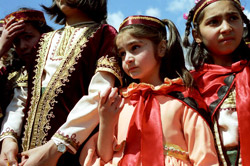 |
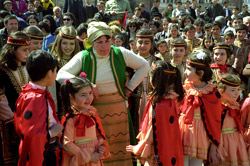 |
 |
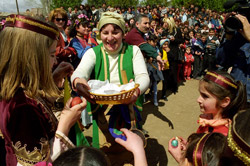 |
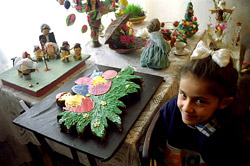 |
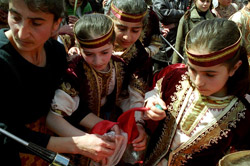 |
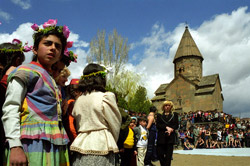 |
During the Divine Liturgy celebrated on Easter Eve (also called the Candle Mass) on Saturday, "When the good news of Christ's Resurrection is given, the seven-week-long Lent is over. Every one lights a candle, tastes the egg they have taken along and bids farewell to Lent."
Even in early Christian times, eggs and dishes prepared from eggs occupied a central place on the Easter table. This was directly related to the ceremonial ideology of the feast.
"The egg was the most beloved object of games, the principal gift item. Young men who were to be married would present a dyed egg as a gift to their brides. In Syunik, the groom's family would send a lamb with a few red eggs tied around its neck, along with fruits and wines, to the bride's family. People would dye the eggs mostly on Holy Saturday or early Sunday morning, sometimes also on Good Friday. They would mainly dye them red, but also yellow, green, blue and other colors. They would often boil the eggs in a copper pot that they had boiled onion peels in first. Before boiling them, they would wrap threads around the eggs to make elaborate patterns," said Samvel Mkrtchyan, a senior staff scientist from the Institute of Archaeology and Ethnography of the National Academy of Sciences.
The ongoing campaign against bird flu has had no effect on Armenians' happy custom, now a ritual, of painting eggs on Easter.
"When the talk about bird flu had just started going around, there were certain worries among the customers, they said they would avoid buying chickens and eggs, but this didn't go on for long," said a clerk at the Giga Supermarket "And people are buying eggs for Easter like they do every year."
"The demand for eggs has risen, and in the last two days suppliers have been having trouble delivering enough eggs," worried Narine Mkhitaryan, a shop assistant at Marine, a grocery store. We heard similar views at the Malatia Supermarket and at Aragats, Lady Nelli, and other grocery stores. The fear of the bird flu has not affected preparations for Easter.
Father Shahen Hayrapetyan, the senior priest at The Church of Saint Sargis, maintains that the egg symbolizes the stone tomb from which "the son of God in his human appearance" rose from the dead.
Saint Grigor of Tatev wrote in 14 th century about dying eggs red: "We dye eggs red on Easter and its symbolism is that the egg is a model of the world and as wise men say, the egg shell is the earth, the membrane is air, the egg white is water, the yolk is fire. And the red dye symbolizes that the entire world was bought at the price of Christ's blood. And we, when taking the red egg into our hands, proclaim our salvation. That is why we first eat the red egg and then the other dishes."
Almost everyone has egg fights on Easter, but children love this tradition most of all. Before a fight they test the egg's hardness by gently cracking it against their teeth. They find different tricks to win the fights. To fight, they crack the eggs against each other with either end, and the winner is the one whose egg cracks the opponent's egg.
In the past, too, Easter dozens of egg games were popular. According to Samvel Mkrtchyan, the most common was cracking the eggs against each other, but there were also games that involved rolling, twisting, squeezing, hiding, and racing with eggs.
"There were many games involving eggs in the Lori-Gugark region. In Djavakhk, after greeting each other on Easter, children and young people would climb onto the roofs for their egg fights. In Zangezur, when the priest sang the Easter Sunday hymn (S harakan) kids would play Tchrran . Old and young alike, men and women would dance to the accompaniment of thezurna and the dhol. The youth would do Kokh(Armenian wrestling). Each district in Lori would choose ropewalkers and Kokh- wrestlers. Each competed against his or her peers," Mkrtchyan said.
One of the main components of the Easter ritual isMerelots (the day of remembrance of the deceased) which, with few exceptions, takes place everywhere on the Monday following the feast.
In the past, there were many popular beliefs accompanying the Easter ritual. People would say that luck was distributed on Easter day and those who slept late that day would lose their portion of luck. Another popular belief held that children born on Easter Day would be wise and have the ability to see into the future.
Photos by Onnik Krikorian
 Videos
Videos Photos
Photos




Write a comment